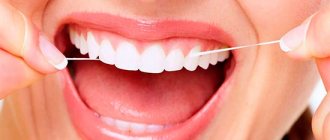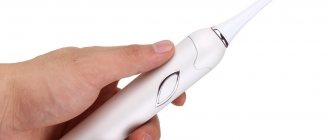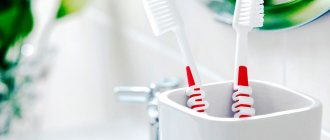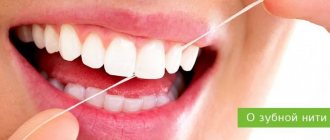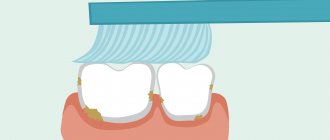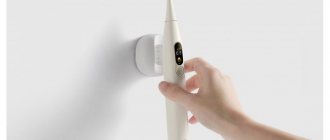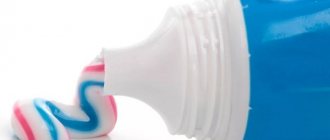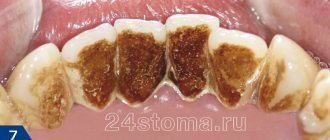Cleaning teeth only with a brush and paste is an ineffective procedure, since removing food fragments and plaque from interdental areas is a difficult task for these hygiene products.
To reduce the risk of developing caries and other inflammatory processes, it is necessary to use dental floss.
Waxed and unwaxed thread: purpose, features, main differences
To ensure that your teeth are properly cleaned, a toothbrush is not enough, since it can only reach the chewing, vestibular and oral surfaces.
The contact areas remain completely unattended. Gradually, plaque and microbes begin to accumulate between the teeth, which release toxins.
As a result, caries, periodontitis and other unpleasant problems appear.
Dental floss is intended for complete, high-quality cleaning of teeth. With their help, you can clean your teeth quickly, accurately and, most importantly, without injury. Dental floss, or floss, has become very popular only some time ago, but has already proven its effectiveness and ease of use.
The floss products on the market for oral hygiene products have some differences. If we omit the differences in shape and size, we can distinguish two main groups:
- Waxed. They are covered with a layer of wax, thanks to which they glide easier and penetrate deeper into the interdental space. The structure of this floss is quite dense. This is the best option for those who have dense teeth or many fillings.
- Unwaxed. Unlike the previous variety, they do not have any additional layer. They penetrate deep enough into the interdental space. They are very economical because they are divided into several thin threads.
Flosses themselves do not harm the teeth, but using them incorrectly can actually cause harm. It is important that the movements of the floss are careful and not sharp, otherwise there is a high risk of damage to the gums. Additionally, you should not floss too often as this can damage your tooth enamel.
Benefits and harms
The benefits of using dental floss are as follows:
- normalization of acidity;
- reduction of plaque on tooth enamel;
- preventing the development of gum disease, caries, and stone formation;
- getting rid of bad breath from the mouth.
The use of hygiene products such as floss, toothbrush and mouthwash in combination significantly reduces the risk of dental diseases.
Improper flossing can cause a number of problems:
- mechanical damage or irritation of gum tissue;
- injury to the tongue and cheeks, which can cause the spread of infection;
- destruction of seals.
Periodic damage can lead to tooth loss.
Advantages and disadvantages of products
To choose the most suitable dental floss model, you need to have an idea of what is good about each of them and what disadvantages they have. Let's start with, perhaps, the simplest option - unwaxed thread. Among the strengths of the product are:
- The ability of the thread to “fluff”. Allows you to capture a larger tooth surface and remove more plaque.
- The floss fits tightly to the teeth. Allows you to remove dirt more effectively.
- Hypoallergenic. Due to the fact that there is no impregnation on the floss, natural fiber is completely safe and will not cause a negative reaction from the body.
On the other hand, the advantages of unwaxed thread can become its disadvantages. For example, the tightness of the thread is ensured by its insufficient slipperiness. If you make sudden movements with your hands, such a floss can cause injury to your gums, which means you should handle unwaxed floss very carefully. In addition, the lack of impregnation significantly reduces the shelf life of the product (no more than 3 years).
Waxed thread is safer precisely because of its impregnation. Dentists recommend such threads for young children and patients who have no experience with flossing. Waxed threads are also highly durable: the likelihood that the thread will break during the procedure is minimal. Waxed thread is stored longer (up to 5 years) and often contains additional components in the impregnation that protect against caries and effectively freshen breath.
Which thread to choose?
There is no clear answer to the question of which type of thread is better, waxed or not.
When choosing the right one, it is necessary to take into account the structural features of the teeth, age, experience in using the product, sensitivity of the gums, possible allergic reaction to certain components of the thread, etc.
Floss is great not only for removing interdental plaque, germs and food debris. Experts recommend using floss on a regular basis for those who have special orthopedic/orthodontic structures installed in the oral cavity.
Having decided on the need for impregnated dental floss, you can move on to the second important point in choosing a floss - its shape:
- Flat. For those whose teeth are very tightly packed, it is advisable to use exclusively flat options (it is better if the floss is wax-impregnated to avoid the risk of gum injury).
- Volume. This is the optimal product for people with serious dental problems (periodontal problems, gum recession, bleeding gums, exposed nerves, etc.)
- Round. An excellent option for people who have a fairly large distance between their teeth in the dentition.
- Tape. If you are the owner of wide gaps between your teeth, then this floss is most suitable for you.
Read also: How to strengthen teeth at home
Thanks to this feature, superfloss is a real salvation for those who have unevenly located dental units in the oral cavity or who have dental structures installed.
Why not a toothpick?
Brushing your teeth is not a 20th-century invention: cleaning teeth from food debris was considered a sign of good manners long before the invention of dental floss. And they did this with the help of toothpicks - and they were often made of gold, silver, with embossing and enamels, and cleaning your teeth in public with toothpicks was considered a special chic.
Today, toothpicks have not disappeared anywhere, although they have turned into unremarkable sticks made of wood or plastic. Many people think that cleaning the spaces between teeth with toothpicks is much more convenient and better than using dental floss. At a minimum, it’s much simpler - you don’t need to wrap anything around your fingers, just take one toothpick out of the pack and get to work!
However, dentists are very wary of toothpicks. They cannot serve as an adequate replacement for floss, since dental floss is designed specifically to remove plaque and food debris from the interdental spaces with minimal trauma. With the correct choice of dental floss and its correct application, the gingival papillae and ligaments of the tooth are not injured. Thanks to the elimination of plaque and food debris, the floss serves to prevent caries and periodontal diseases.
A toothpick is simply unable to get into the interdental space, since its tip is thicker than the distance between the teeth. You can only hook the edge of the dietary fiber and pull it out of the gap. Toothpicks are also often used by patients with carious cavities and periodontal pockets. But a toothpick cannot remove plaque; its sharp tip often damages the gums and ligaments of the tooth, and sometimes pushes food debris deeper into the periodontal pocket. All this can aggravate the condition of the gums, and not clean the teeth.
How to use floss correctly
In order not to damage your teeth and especially your gums, you must use dental floss very carefully, act slowly, and be gentle with your teeth:
- Wrap about 40 cm of floss around your index/middle fingers in several layers.
- Gently grasp the floss with your thumbs and forefingers so that the distance between your hands is no more than 5 cm.
- Pull this section of the floss taut so it can easily fit between your teeth.
- Gently move the floss up and down along the tooth.
- Slowly and carefully move to the tooth line located under the gum.
- To avoid damaging your gums, use circular movements.
- Repeat the procedure for each tooth.
If this is your first time using floss to clean your teeth, there are a few important things to remember.
- First, a new piece of floss must be unwound for each tooth (under no circumstances should floss be reused).
- Secondly, be sure to treat the back of your teeth (a considerable amount of bacteria and plaque accumulates there).
- Thirdly, if you cannot hold the floss, use a special device - a flosser (usually it can be purchased at a pharmacy). If even this does not help you, be sure to contact your dentist, who will help you choose another product for additional cleaning of your teeth.
Dentists do not have a clear answer to the question of how often you should floss. However, many agree that floss can be walked along the teeth after each meal, and if the floss is impregnated with fluoride, then it is undesirable to use it more than once a day. For those with bleeding gums, it is enough to floss a couple of times a week.
As you can see, choosing dental floss is not an easy task. But, if you have an idea of what they are and how they are used depending on the existing differences, choosing the right floss becomes much easier. Take care of your teeth and visit the dentist promptly. Be healthy!
How to use thread
Dentists recommend starting to floss at the age of 10, but children need to do this under adult supervision. If you decide to use it at an older age, still consult your doctor first. When using dental floss for the first time, a number of difficulties may arise. But this is a temporary phenomenon, very soon you will get used to it and notice the first improvements in your teeth.
Here is an approximate sequence of actions:
- Unwind 50–60 mm of thread.
- Cut it with a knife, which is located in the upper section of the case.
- The floss is wound around the index fingers of both hands. After this, insert it between the teeth, you should get a structure resembling the letter C.
- Start moving the floss back and forth and up and down.
- Be careful when the thread comes into contact with the gum so as not to damage it.
The video shows how to properly use dental floss:
Whether or not to floss is up to everyone. But it has been scientifically proven that people who floss are less likely to develop dental problems. If you brush between your teeth after every meal, you are unlikely to suffer from oral diseases.
The article was prepared under the editorship of doctors - dental implantation center ICDI ROOTT
What is the difference between waxed dental floss and unwaxed floss?
There are many varieties of the products in question on the market. The difference lies in the material (synthetic or natural fibers), shape (round, flat, ribbon threads). But dentistry divides all these products into two types: flosses with and without impregnation.
The only difference between waxed and unwaxed dental floss is that it is impregnated with wax, as well as additional substances that have an antibacterial and flavoring effect. But such a seemingly insignificant detail gives the product many useful qualities. Floss soaked in wax penetrates more easily into the interdental spaces and glides along the walls of the unit being cleaned.
Unwaxed dental floss has the ability to fluff up during use. This factor gives floss a number of positive characteristics. And, of course, the type of thread in question has its weaknesses.
Experts say it is important to know about the effects of these two types of products. The information will help you determine which thread is best for you.
Differences
In the floss production process, synthetic materials (nylon, nylon or acetate) are used, less often natural silk. A thread may consist of one or more fibers.
The difference lies in the method of additional surface treatment; products can be:
- impregnated with beeswax;
- raw threads.
How are they different from each other? Waxed floss is often impregnated with sodium fluoride , which has a preventive anti-caries effect, and menthol, which deodorizes the oral cavity.
Fluorine and chlorhexidine, used more often in the manufacture of unwaxed products, have a bactericidal effect and serve as a softening agent for the thread: in terms of sliding speed, such a product is more reminiscent of floss impregnated with the waste product of bees.
Advantages and disadvantages of waxed thread
Let's look at the positive and negative aspects of using impregnated floss.
The fact that the floss glides more easily and penetrates into the narrowest spaces between teeth allows dentists to recommend it to children and adult patients who do not have flossing skills. Wax and other impregnation components give the surface of the fibers smoothness. This reduces the likelihood of cutting your gums after an accidental, careless movement.
Another advantage is that quite often the manufacturer adds sodium fluoride and menthol to the impregnation composition. The first component has a preventive effect in the formation of caries. Menthol helps freshen breath.
Read also: A lot of white coating on the tongue
Also, do not forget that waxed threads have good strength - they do not break during the hygiene procedure.
Due to the chemical composition of the impregnation, waxed threads are stored better. The shelf life of the products is 5 years or more. This factor reduces the likelihood of purchasing a stitched product.
Advantages and disadvantages of unwaxed thread
The difference between unwaxed and waxed dental floss gives them differences in positive characteristics. The ability of floss to fluff makes it more effective in fighting plaque. Once separated into fibers, the thread covers a large area of the surface being cleaned. Due to this feature, floss better removes all food particles between the teeth. In addition, the tight fit to the wall of the unit ensures effective cleaning of plaque.
Unwaxed floss is hypoallergenic. A thread made of natural fiber, not impregnated with chemical components, does not cause negative reactions.
The characteristics that are advantages of the flosses under consideration, on the other hand, are also disadvantages. Due to the fact that the thread is not slippery enough, the chance of damage to the gums during the hygiene procedure (impacts, cuts) increases. This means that you need to use unwaxed floss very carefully.
In addition, the lack of impregnation affects the shelf life of the product (no more than 3 years). Experts draw attention to the fact that it is especially important to use the thread in time after opening the package.
Which one to choose?
The best dental floss is considered to be any properly selected product. The origin in this case does not play a major role, because no matter how pleasant silk is to the touch, frequent breaks make the hygienic procedure uncomfortable.
Of the existing types of floss, products made from nylon and Teflon deserve attention. Both options perform the functionality equally well, the second, however, is an order of magnitude higher in cost.
According to the analysis of user reviews, we can conclude that the decisive role in the choice is played by the correspondence of the characteristics/properties of the floss and the condition of the soft/bone tissues of the oral cavity.
Benefits of a floss holder
Rules for using dental floss
Which dental floss is better - waxed or unwaxed?
Experts say that it is impossible to unequivocally answer the question, which dental floss is better - waxed or unwaxed? Flosses need to be selected taking into account the individual characteristics of the patient, his age, and skills. Read more about the features of using dental floss →
It is worth paying attention to the fact that dental floss is intended not only to cleanse the interdental spaces from food debris and accumulated plaque. Dentists recommend using floss for patients who have removable or non-removable orthodontic and orthopedic structures installed.
When choosing a thread, you need to take into account the location of the units in a row. Manufacturers have created these products with different cross-sections. Therefore, if you have decided whether your floss should be impregnated, then pay attention to additional nuances:
- The cross-section of the thread is round - suitable for people with large gaps between teeth.
- Flat shaped floss. They are designed for patients with tightly packed units in a row. If your teeth are crowded, you should give preference to this type of product (preferably impregnated with wax).
- bulky threads for people suffering from periodontal diseases, as well as gum recession and exposed root areas.
- Tape floss is good for cleaning the tooth surface in the presence of trema and diastemas (cracks).
Not long ago, threads called superflosses appeared on the market. Their difference is that the hygiene product has areas of different diameters. Such products can be purchased for patients who have unequal widths between units in a row. The thread also cleans orthodontic and orthopedic structures well.
Experts draw attention to the fact that proper oral care is the best prevention of diseases of the teeth and gums. And thanks to the variety of products on the market, everyone will be able to choose suitable personal hygiene products for themselves.
Author: Tatyana Grosova, dental assistant, especially for Karies.pro
Are there any contraindications for flossing?
Although reviews from those who floss regularly say that it improves their daily hygiene, flossing is not for everyone. Dental floss has its own contraindications:
- the presence of crowns and (or) bridges - floss can only be used with the permission of the treating dentist, as there is a possibility of damaging the dentures;
- caries, especially with large cavities and significant destruction of hard tissue - floss can cause bleeding if it gets caught on the edge of the cavity; it can be used only after treatment, when the gums have healed;
- gum disease - use floss only after consulting a periodontist! Especially if you have loose teeth;
- Age up to 8 years - a high risk of injury to teeth and gums, and the child will not be able to floss on his own.
Remember: flossers and threads in a spool are intended for one-time and strictly individual use only! Always throw away the used floss or flosser and do not allow anyone other than you to floss. Also, flossing cannot replace brushing and paste cleaning. It is an additional means of hygiene.
